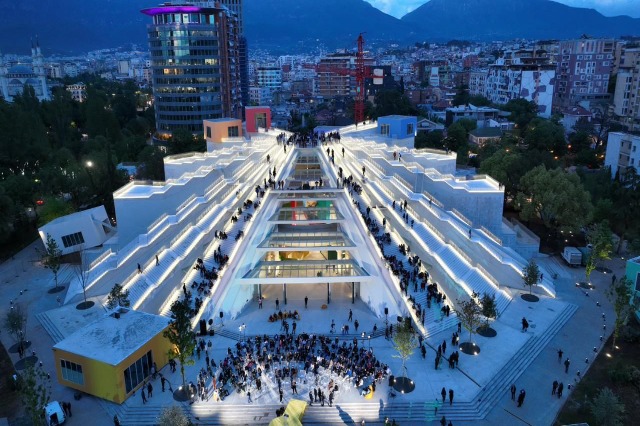The Pyramid of Tirana, known locally as Piramida e Tiranës, is one of the most intriguing and controversial structures in Albania.
It stands as a symbol of the country’s complex history, embodying the transition from its communist past to its uncertain present and future. Here’s a more detailed look at the Pyramid of Tirana:
The Pyramid of Tirana stands as a stark reminder of Albania’s tumultuous past, yet its transformation symbolizes the nation’s resilience and its hope for a brighter future.
Anna Apartments
Historical Background
Origins: The Pyramid was originally conceived as a museum dedicated to Enver Hoxha, Albania’s communist dictator who ruled the country with an iron fist from 1944 until his death in 1985. Hoxha’s daughter, Pranvera Hoxha, along with a group of architects that included her husband, Klement Kolaneci, and engineers Pirro Vaso and Vladimir Bregu, designed the structure. The museum was intended to showcase Hoxha’s life and achievements, serving as a grand monument to his legacy.
Construction: The Pyramid was inaugurated in October 1988, just three years after Hoxha’s death. At the time of its opening, it was the most expensive structure ever built in Albania. The design, a futuristic and brutalist concrete pyramid, was meant to symbolize both Albania’s forward-looking ambitions and Hoxha’s enduring influence. The building was filled with exhibits about Hoxha’s life, his role in the Albanian communist movement, and the country’s development under his regime.
Architecture and Design
Architectural Style: The Pyramid is a striking example of brutalist architecture, a style characterized by its stark, angular forms, and use of raw concrete. The structure’s design is a departure from the traditional, symbolizing modernity and the ambition of Albania under communism. The Pyramid’s interior originally featured large exhibition spaces, multimedia displays, and propaganda materials, all aimed at glorifying Hoxha’s legacy.
Symbolism: The shape of the Pyramid was intended to reflect stability and permanence, while also echoing ancient forms associated with power and eternity. Its unique design makes it one of the most recognizable buildings in Tirana, although its symbolism has evolved over the years, from a tribute to a controversial leader to a contested relic of the past.
Post-Communist Era
Abandonment and Repurposing: After the fall of communism in the early 1990s, the Pyramid quickly lost its original purpose. The museum was closed, and the building was repurposed several times over the following decades. It served as a conference center, an exhibition space, a nightclub, and even a NATO base during the Kosovo War in the late 1990s. Despite these various uses, the building fell into disrepair, and its future became a topic of ongoing debate.
Cultural Significance: The Pyramid has become a symbol of Tirana’s transformation and the complex legacy of its communist past. While some view it as a valuable piece of architectural heritage, others see it as a painful reminder of the dictatorship. This divide has fueled discussions about whether the structure should be preserved, repurposed, or demolished.
Urban Playground: Over the years, the Pyramid has taken on a new life as an unofficial urban playground. Its sloping sides, originally intended as a design feature, have become a popular attraction for locals, especially the youth, who climb to the top for a panoramic view of the city. This informal use of the space highlights the building’s evolving role in the community, from a monument of power to a site of everyday recreation.
Recent Developments and Renovation
Renovation Plans: In recent years, there have been multiple proposals to renovate and repurpose the Pyramid. In 2017, the Albanian government announced plans to transform the structure into a multi-functional center for culture, technology, and innovation. The new design, led by the Dutch architecture firm MVRDV, aims to preserve the Pyramid’s iconic shape while updating its interior for modern use. The project includes the creation of spaces for exhibitions, workshops, and cultural events, as well as areas for tech startups and digital learning.
Cultural Center: The renovated Pyramid is envisioned as a cultural hub for the city, fostering creativity, education, and community engagement. The redesign plans to integrate the building more effectively into Tirana’s urban landscape, making it a focal point for the city’s youth and a symbol of its forward-looking aspirations.
Public Opinion: The renovation project has garnered mixed reactions. While many support the idea of repurposing the Pyramid into a modern cultural center, others argue that the building should either be preserved in its original state as a historical monument or demolished to erase the legacy of dictatorship. Despite the controversy, the Pyramid remains a subject of fascination and a potent symbol of Tirana’s evolving identity.
The Pyramid of Tirana, with its controversial past and uncertain future, is one of the most compelling sites in the city, embodying both the challenges and the possibilities of a nation in transformation.
